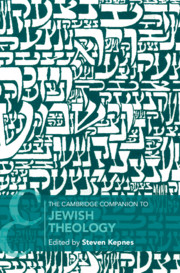Book contents
- The Cambridge Companion to JEWISH THEOLOGY
- cambridge companions to religion
- the cambridge companion to JEWISH THEOLOGY
- Copyright page
- Contents
- Notes on Contributors
- Acknowledgements
- 1 Introduction
- 2 What is Jewish Theology?
- Part I Biblical-Rabbinic
- Part II Medieval
- 6 Maimonides’ Theology
- 7 Law and Order: The Birth of a Nation and the Creation of the World
- 8 The Mystical Theology of Kabbalah: From God to Godhead
- Part III Modern
- Part IV Contemporary Issues
- Part V Analytic Philosophy and Theology
- Index
- Other Titles in the Series (continued from page ii)
- References
8 - The Mystical Theology of Kabbalah: From God to Godhead
from Part II - Medieval
Published online by Cambridge University Press: 03 December 2020
- The Cambridge Companion to JEWISH THEOLOGY
- cambridge companions to religion
- the cambridge companion to JEWISH THEOLOGY
- Copyright page
- Contents
- Notes on Contributors
- Acknowledgements
- 1 Introduction
- 2 What is Jewish Theology?
- Part I Biblical-Rabbinic
- Part II Medieval
- 6 Maimonides’ Theology
- 7 Law and Order: The Birth of a Nation and the Creation of the World
- 8 The Mystical Theology of Kabbalah: From God to Godhead
- Part III Modern
- Part IV Contemporary Issues
- Part V Analytic Philosophy and Theology
- Index
- Other Titles in the Series (continued from page ii)
- References
Summary
In this essay I survey the development of the Kabbalistic Godhead; exploring sources from the Hebrew Bible, through rabbinic literature and medieval Jewish philosophy, and culminating in thirteen century kabbalah and the Zohar. Following this discussion, I discuss primary theological elements incorporated within this conception, such as the understanding of the ten sefirot, which comprise the Godhead, the mystical understanding of the Tetragrammaton as correlating to the divine essence, God’s identification with the Torah and commandments, and the feminine element of the Godhead. This examination of the configuration of the Godhead and its various elements naturally leads to a discussion of the “complex unity” of God. In this examination I discuss the relation of different divine persona within the Godhead, the evil or demonic element of the Godhead, and lastly the differing conceptions of the Godhead as a kataphatic or apophatic entity. Finally, I examine the phenomenon of mystical union between the human being and the Godhead.
- Type
- Chapter
- Information
- The Cambridge Companion to Jewish Theology , pp. 149 - 182Publisher: Cambridge University PressPrint publication year: 2020



